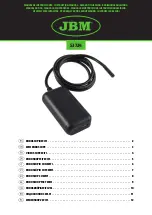
27
If you do not see a device responding to your Ping command as shown in Figure 25, the test is
complete and you may proceed to configure the SafeLINC FPII to operate on the local network.
The results in Figure 25 indicate that there is no other device on the network responding to the
address provided by the MIS/IT Department. Proceed to configure the SafeLINC FPII.
C:\>ping 10.26.3.194
Pinging 10.26.3.194 with 32 bytes of data:
Reply from 10.26.3.194: bytes=32 time<10ms TTL=60
Reply from 10.26.3.194: bytes=32 time<10ms TTL=60
Reply from 10.26.3.194: bytes=32 time<10ms TTL=60
Reply from 10.26.3.194: bytes=32 time<10ms TTL=60
Ping statistics for 10.26.3.194:
Packets: Sent = 4, Received = 4, Lost = 0 (0% loss),
Approximate round trip times in milli-seconds:
Minimum = 0ms, Maximum = 0ms, Average = 0ms
C:\>
Figure 26. Unexpected Results (Device Response to Ping Command)
However, if you do see a device responding to your Ping command as shown in Figure 26, contact
the MIS/IT Department.
DO NOT attempt to configure the SafeLINC FPII on the network until
the problem is fixed.
Connecting a PC to the SafeLINC FPII Diagnostic & Configuration Port,
Continued
Checking for
Duplicate IP
Addresses
Summary of Contents for SafeLINC 4020-0160
Page 2: ......
Page 55: ...49 MIS IT Configuration Worksheet...
Page 56: ...50 MIS IT Configuration Worksheet Continued...
Page 57: ......
















































